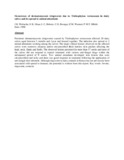| dc.contributor.author | J K, Wabacha | |
| dc.contributor.author | G K, Gitau | |
| dc.contributor.author | L C, Bebora | |
| dc.contributor.author | C.O, Bwanga | |
| dc.contributor.author | Z M, Wamuri | |
| dc.contributor.author | P M F, Mbithi | |
| dc.date.accessioned | 2013-02-25T08:58:18Z | |
| dc.date.issued | 1998 | |
| dc.identifier.citation | Journal of the South African Veterinary Association (1998) 69(4): 172-173 | en |
| dc.identifier.uri | http://erepository.uonbi.ac.ke:8080/xmlui/handle/123456789/11110 | |
| dc.description.abstract | Persistent dermatomycosis (ringworm) caused by Trichophyton verrucosum affected 20 dairy calves aged between 3 months and 1year and housed together. The infection also spread to 2 animal attendants working among the calves. The major clinical lesions observed on the affected calves were extensive alopecia and/or circumscribed thick hairless skin patches affecting the head, neck, flanks and limbs. The observed lesions persisted for more than 17 weeks and most of the calves did not respond to topical treatment with various anti-fungal drugs within the anticipated period of 9 weeks. Two animal attendants developed skin lesions that were circumscribed and itchy and there was good response to treatment following the application of anti-fungal skin ointment. Although ringworm in dairy animals in Kenya has not previously been associated with spread to humans, the potential is evident from this report.
Key words: bovine, ringworm, zoonosis. | en |
| dc.language.iso | en | en |
| dc.subject | Bovine | en |
| dc.subject | Ringworm | en |
| dc.subject | Zoonosis | en |
| dc.title | Occurrence of dermatomycosis (ringworm) due to Trichophyton verrucosum in dairy calves and its spread to animal attendants | en |
| dc.type | Article | en |
| local.publisher | Department of Clinical Studies, Faculty of Veterinary Medicine, University of Nairobi | en |

